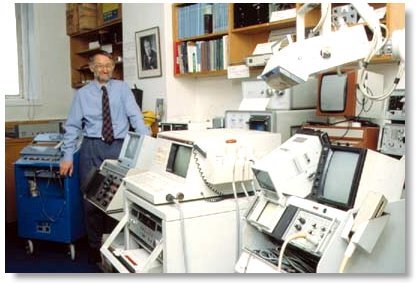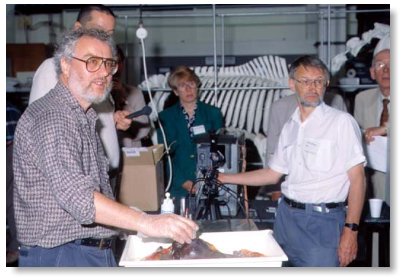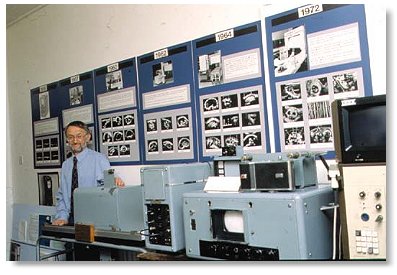John Eric Edgcumbe Fleming was born in 1934. He started his career with the EMI Engineering Development Ltd in 1951. Between 1951and 56, he worked on the development of specialised test equipment for radar and later on computer development with John Drage and Godfrey Houndsfield; Drage went on to lead the team which developed the first desk calculator and Houndsfield to develop Computerised Tomography. During his time at EMI Fleming obtained a HNC with distinctions in Electrical Engineering.
In 1956 he moved to Ferranti Ltd as a Development Engineer on computer logic elements and data transmission systems. Then to avoid the increasing involvement in military projects he moved to Smiths Industries Ltd in Glasgow, Scotland. There he joined Tom Brown who was working with Professor Ian Donald. Following Brown's move to another company Fleming became responsible for the development of medical ultrasonic products, principally the Diasonograph. This static B-Scan machine was the first scanner to go into commercial production. However only twelve had been delivered when Smiths decided to close the factory in Glasgow. After the sale of the medical ultrasound interest production and further development continued at Nuclear Enterprises Ltd in Edinburgh under Brian Fraser, from Smiths, and Tom Brown who had returned to the ultrasound world.
For some time before Smiths' closure Angus Hall had also been working on medical ultrasound. Following the closure in 1967 they both joined Professor Donald in the University of Glasgow at his Department of Midwifery in the newly built Queen Mother's Hospital. The personal connection with Fraser and Brown fostered active cooperation between Professor Donald's department and Nuclear Enterprises. In 1982 Hall moved to become Head of Medical Physics at St James's University Hospital, Leeds.
In 1984 partly as a result of having agreed to care for the original contact scanner (built by Tom Brown in 1954) and used by Ian Donald, Fleming was asked by the British Medical Ultrasound Society (BMUS) to establish an Historical Collection. In 1988 following an agreement between the University of Glasgow's Hunterian Museum and BMUS the Museum undertook to provide long term care for the Collection. Fleming was appointed Honorary Assistant Keeper of Ultrasonic Equipment to the Museum.
The Collection now contains over sixty items of hardware, scanners and associated equipment, a wide range of manufacturer's literature and a substantial and increasing archive of unique documents.
Since 1995 Fleming has been working closely with Dr Malcolm Nicolson of the Wellcome Unit for the History of Medicine, University of Glasgow. They, together with Dr Ian Spencer, are co-authoring a book on the history of ultrasound development in Glasgow. Fleming's work in establishing the BMUS Collection was recognised in 1994 with the award of Honorary Membership of the Society and the Geddes-Davis Shield, from the British Institute of Non Destructive Testing in 1997.
Mr. Fleming has contributed to over 60 papers on ultrasonics and given numerus lectures and talks at important International meeings. In addition to his work in establishing the Historical Collection Fleming contributed to BMUS as Honorary Treasurer, 1972 - 78, and in the organisation of the BMUS Annual Meetings in 1972 and 1988. Additionally he was Financial Director for the World Federation meeting in Brighton, UK (WFUMB 1982). Following retirement in 1995 John Fleming retains a close link with the University as an Honorary Research Associate. He continues as Coordinator of the BMUS Historical Collection until 2004.
He received the Faraday Medal from The Institution of Engineering and Technology (IET) in 2021 for his pioneering work in the invention of an ultrasonic device in Obstetrics and Gynaecology.
 Mr. Fleming with a few of the scanners in the BMUS Historical Collection c. 1996. In the foreground are machines from KretzTechnik®, Philips® and ADR®.
Mr. Fleming with a few of the scanners in the BMUS Historical Collection c. 1996. In the foreground are machines from KretzTechnik®, Philips® and ADR®.
 Left to right: Dr Malcolm Nicolson, Dr Ian Spencer (partly hidden), Dr Margaret McNay, Mr. Fleming and Dr James Willocks during the re-enactment of Professor Ian Donald's first experiments originally carried out on the premises of Babock and Willcox Ltd. This re-enactment took place in a laboratory of the University of Glasgow Department of Veterinary Anatomy (The assistance of Professor J Boyd is gratefully acknowledged).
Left to right: Dr Malcolm Nicolson, Dr Ian Spencer (partly hidden), Dr Margaret McNay, Mr. Fleming and Dr James Willocks during the re-enactment of Professor Ian Donald's first experiments originally carried out on the premises of Babock and Willcox Ltd. This re-enactment took place in a laboratory of the University of Glasgow Department of Veterinary Anatomy (The assistance of Professor J Boyd is gratefully acknowledged).
 Mr. Fleming with the contact scanner designed and built by Tom Brown and used by Professor Ian Donald and Dr John MacVicar c 1957. On the wall are panels describing the development of medical ultrasound in Glasgow up to the time of Professor Donald's retirement.
Mr. Fleming with the contact scanner designed and built by Tom Brown and used by Professor Ian Donald and Dr John MacVicar c 1957. On the wall are panels describing the development of medical ultrasound in Glasgow up to the time of Professor Donald's retirement.
Read also: "Chapter 1: Medical Ultrasound - germination and growth". J.E.E. Fleming, I.H. Spencer and M. Nicholson, in Clinical Diagnostic Ultrasound, Baxter G M, Paul L P Allan and Patricia Morley, Eds. Blackwell Publishing. 2nd Edition, 1999. and
"Forty Years of Obstetric Ultrasound 1957-1997: From A-scope to Three Dimensions". Margaret B McNay and John E.E. Fleming. Ultrasound in Med. & Biol., Vol. 25, No. 1, pp. 3 - 56, 1999.
Pictures courtesy of Mr. John Fleming.
Back to History of Ultrasound in Obstetrics and Gynecology.